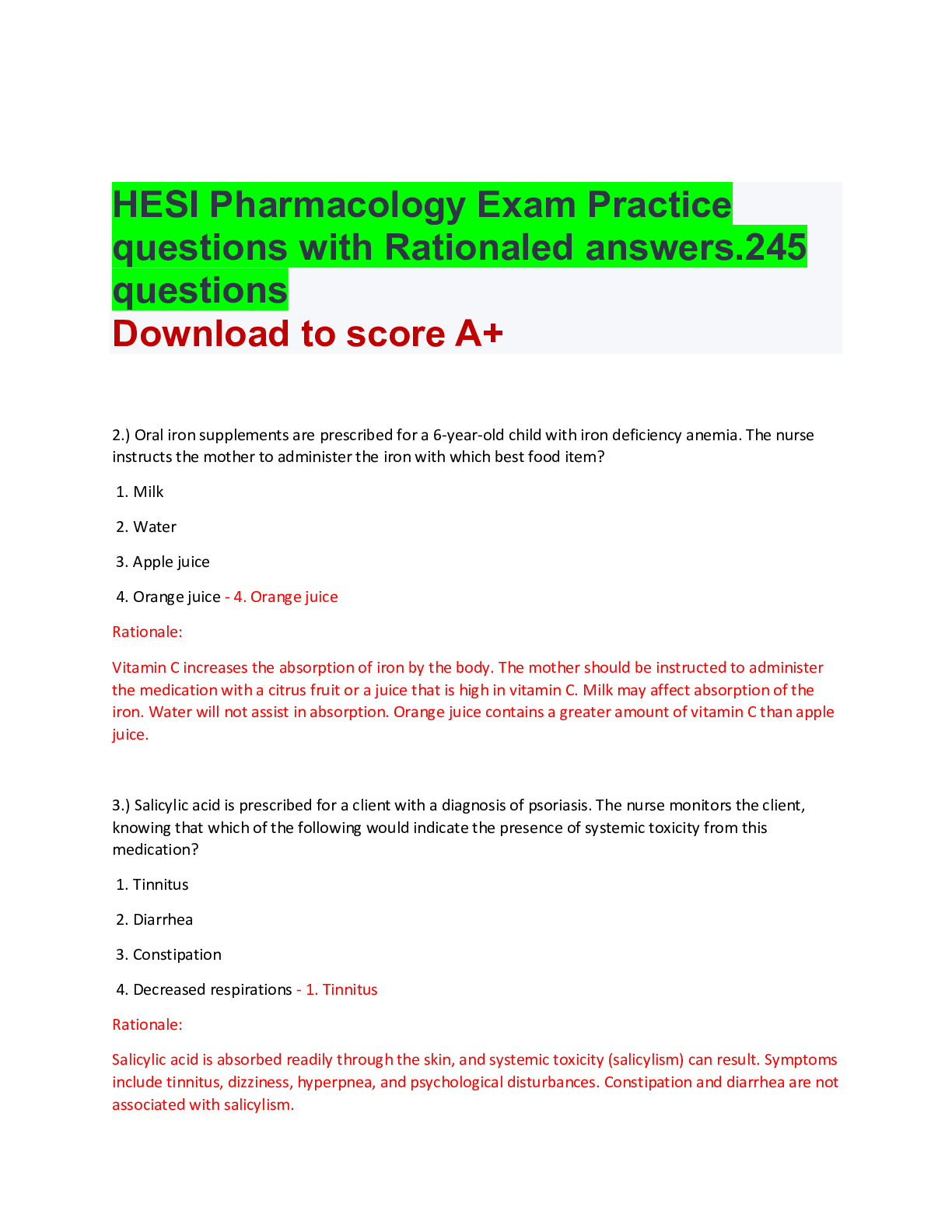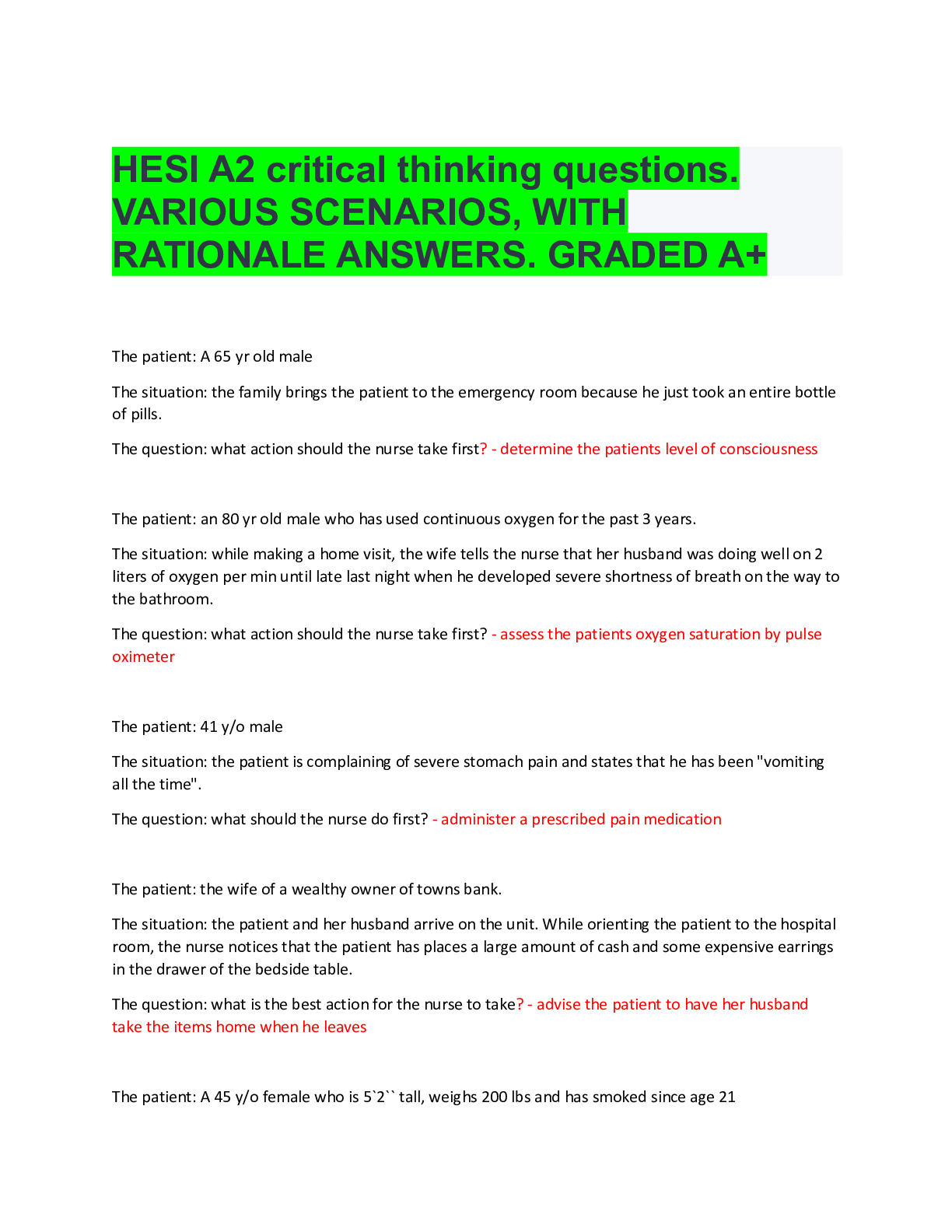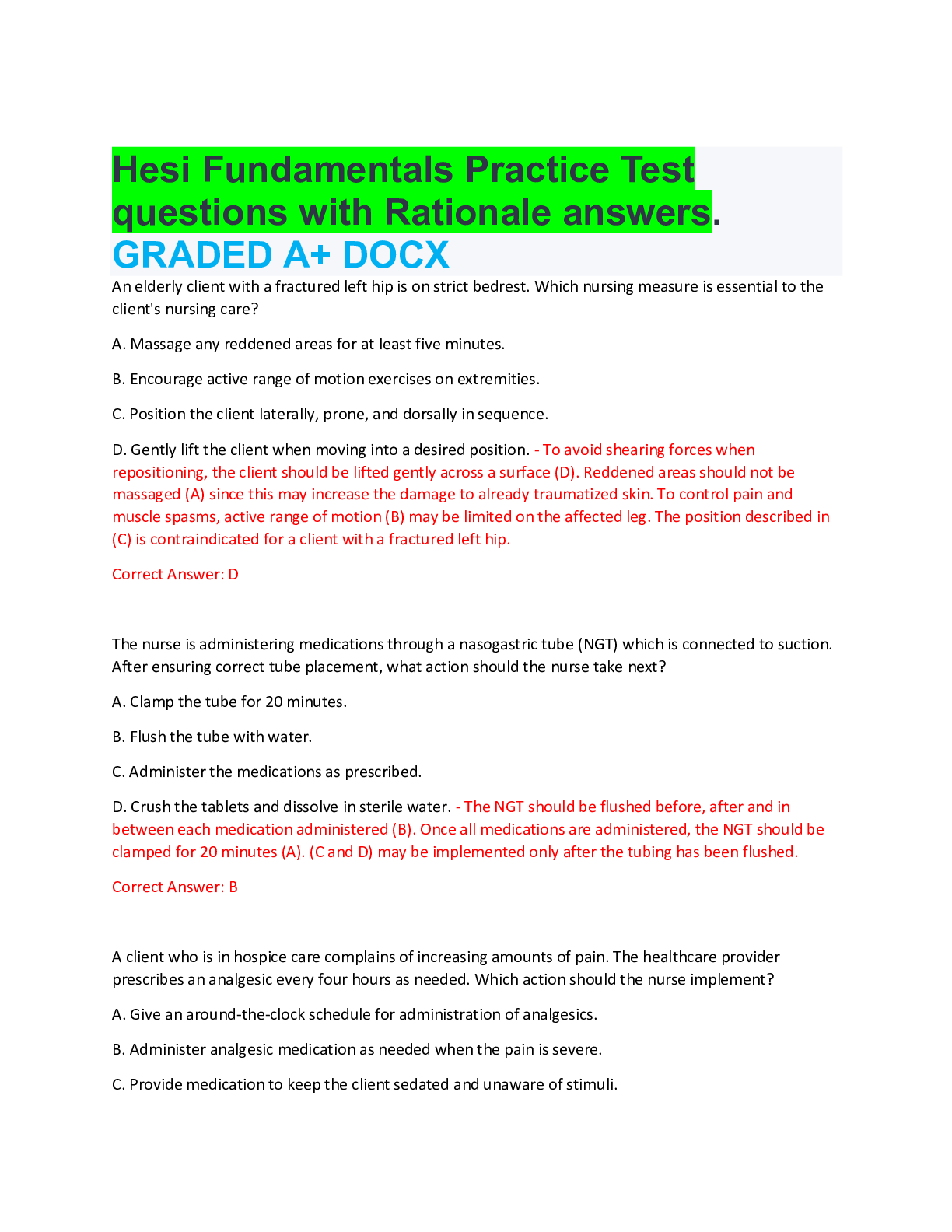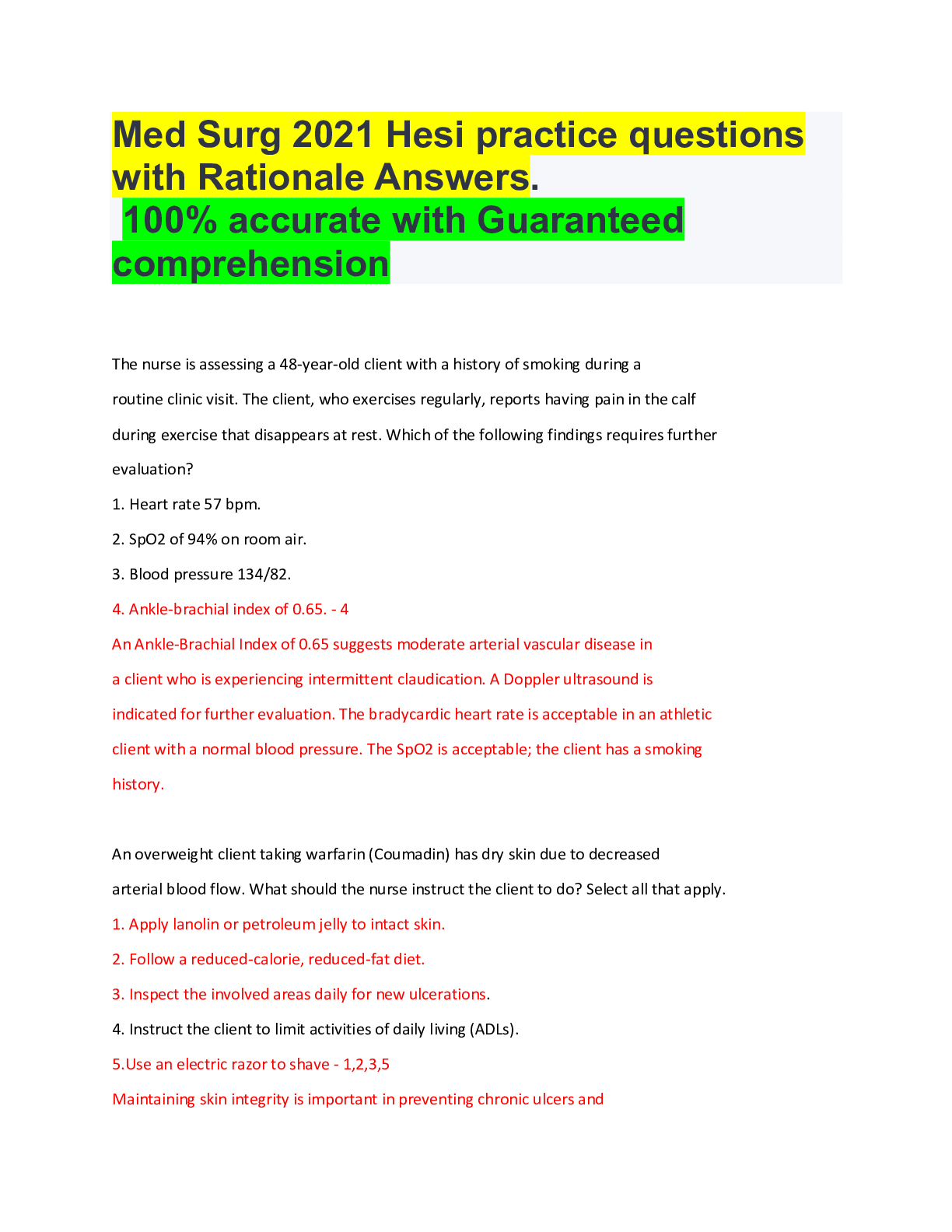*NURSING > HESI > NURS 209 Practice Questions HESI (PATHO BOOK). Latest Bank Questions with rationale answers (All)
NURS 209 Practice Questions HESI (PATHO BOOK). Latest Bank Questions with rationale answers
Document Content and Description Below
A decrease in workload, use, pressure, or blood supply appropriately describes: A. physiologic atrophy. B. pathologic atrophy. C. hypertrophy. D. hyperplasia. - B. pathologic atrophy. Pathologi... c atrophy is a decrease in cell size due to decreased use. Physiologic atrophy usually occurs early in development; for example, the thymus gland atrophies during childhood. Hypertrophy is an increase in cell size. Hyperplasia is an increase in the number of cells. The appropriate term for the reversible replacement of one mature cell by another is: A. metaplasia. B. hyperplasia. C. dysplasia. D. atypical hyperplasia. - A. metaplasia. The term metaplasia refers to one cell type being replaced by another. Hyperplasia is an increase in the number of cells, not a change in their type. Dysplasia, also referred to as atypical hyperplasia, refers to abnormal changes in the size, shape, and organization of cells. The ability to increase intracellular calcium concentrations and affect the nervous and hematopoietic systems is a characteristic of: A. carbon monoxide. B. carbon tetrachloride. C. lead. D. mercury. - C. lead. Lead is able to increase intracellular calcium concentrations and may also become a calcium substitute. It affects the hematopoietic system. It is often found in paint, dirt, and pottery. Carbon tetrachloride, formerly used in dry cleaning, is converted into a highly toxic free radical that damages the liver. Carbon monoxide is an asphyxiate gas that interrupts respiration. Mercury is a heavy metal and can worsen chronic diseases like Alzheimer disease and multiple sclerosis. A patient with a collection of blood that is located between the skull and the dura is diagnosed with a condition referred to as a(n): A. epidural hematoma. B. contusion. C. subdural hematoma. D. abrasion. - A. epidural hematoma. An epidural hematoma is a collection of blood between the inner surface of the skull and the dura. A subdural hematoma is a collection of blood between the surface of the dura and the brain. A contusion is a bruise or bleeding into the skin and underlying tissue. Abrasion is a scrape caused by removal of the superficial layers of the skin. A tear or rip of the skin with a jagged and irregular edge is described as a(n): A. abrasion. B. incision. C. laceration. D. avulsion. - C. laceration. Lacerations occur when the tensile strength of the skin is exceeded. An incision is a precise cut with an instrument that leaves regular clean edges. In a laceration, edges are often jagged and irregular. An abrasion results from the removal of the superficial layers of the skin caused by friction between the skin and the injuring object. An avulsion is an injury in which an area of tissue is pulled away, creating a flap. A characteristic of a stab wound includes: A. the injury is deeper than it is long. B. the injury is longer than it is deep. C. there is a broken bone. D. there is significant crush injury. - A. the injury is deeper than it is long. The injury is deeper than it is long. There is little crush injury because the object used is sharp and it makes a clean entrance. An injury that is longer than it is deep is considered an incised wound. A broken bone is a fracture. The appropriate term for fragments of burning or unburned pieces of gunpowder that are embedded in the epidermis is: A. exit wound. B. stippling. C. blowback. D. tattooing. - D. tattooing. Tattooing results from fragments of burning or unburned pieces of gunpowder exiting the barrel and striking the skin surface with enough force to be driven into the epidermis. Stippling results when fragments of gunpowder strike the skin with enough force to abrade the skin but not actually penetrate the surface. An exit wound is where the bullet exits the body. Blowback is disruption of the tissues resulting in large, gaping, and jagged appearance to the wound. Which term describes oxygen failing to reach the blood? A. Suffocation B. Strangulation C. Drowning D. Petechiae - A. Suffocation Suffocation occurs when oxygen fails to reach the blood. It is a subgroup of asphyxial injuries. Strangulation is caused by compression and closure of the blood vessels and air passages by external pressure on the neck. Drowning occurs when water or fluid alters delivery of oxygen. Petechiae are found on the neck of a victim who is strangled. It is the result of compression of soft tissue and the breakage of blood vessels. The pigment that is correctly paired with its color is: A. melanin-brown-black. B. hemosiderin-green-black. C. blue nevus-brown-black. D. bilirubin-yellow-brown. - A. melanin-brown-black. Melanin is brown-black pigment. This is what causes a suntan. Hemosiderin is a yellow-brown pigment and is derived from hemoglobin. Blue nevus is a benign mole that is dark blue-black in color. Bilirubin is yellow-green in color and is derived from bile. The appropriate term to identify the nuclear dissolution and destruction of chromatin by action of hydrolytic enzymes is: A. autolysis. B. pyknosis. C. karyorrhexis. D. karyolysis. - D. karyolysis. Karyolysis is the nuclear dissolution and lysis of chromatin. Autolysis is a term for autodigestion. In pyknosis, the nucleus shrinks and becomes a small, dense mass of genetic material. Karyorrhexis means fragmentation of the nucleus into smaller particles, or "nuclear dust." A TRUE statement regarding calcium in cells is: A. calcium salts accumulate in healthy, living cells with normal body function. B. dystrophic calcification occurs in chronic tuberculosis. C. metastatic calcification occurs in damaged tissue. D. psammoma bodies are individual calcium molecules. - B. dystrophic calcification occurs in chronic tuberculosis. Dystrophic calcification occurs in dead or dying tissues and chronic tuberculosis and is usually found in lungs and lymph nodes. Calcium accumulation normally occurs in dead or dying tissues. Psammoma bodies are several layers of calcium that clump together and form grains. Metastatic calcification consists of mineral deposits that occur in undamaged tissue as a result of hypercalcemia. Tuberculous infections are likely to result in a form of necrosis called: A. coagulative. B. liquefactive. C. fat. D. caseous. - D. caseous. Caseous necrosis is normally found in the lung from infection by Mycobacterium tuberculosis. It is a combination of liquefactive and coagulation necrosis. Coagulative necrosis occurs primarily in the kidneys, heart, and adrenal glands due to protein degradation. Liquefactive necrosis occurs commonly in the neurons and glial cells. Fat necrosis occurs in the breast, pancreas, and other abdominal structures and is caused from cellular dissolution by enzymes called lipases. A correct concept related to aging is: A. the maximal life span on humans is 80 to 100 years. B. men outlive women in most countries. C. the maximal life span changes every decade. D. the concept of aging is well understood and documented. - A. the maximal life span on humans is 80 to 100 years. The maximal life span is 80 to 100 years and has not changed over time. The average life span, however, has changed. Women outlive men in most areas of the world. The concept of aging is not completely understood. The term apoptosis is appropriately defined as: A. second messenger system. B. autostimulation. C. programmed cell death. D. pass-it-on signal. - C. programmed cell death. Another term for apoptosis is programmed cell death. Autostimulation is when a cell releases a signal that actually affects the cell of origin. A pass-it-on signal is a description for a second messenger system. A second messenger system is a means by which a ligand binds with receptors of a membrane system and then triggers a second system/reaction. The process of atrophy is a result of: Select all that apply: A. aging. B. lack of blood supply. C. work demand. D. hormonal stimulation. E. need to replace lost cells. - A. aging. B. lack of blood supply. D. hormonal stimulation. Atrophy is a decrease in cellular size caused by aging, disuse or lack of blood supply, hormonal stimulation, or neural stimulation. Hypertrophy is an increase in the size of cells caused by increased work demands or hormonal stimulation. Hyperplasia is an increase in the number of cells caused by an increased rate of cellular division. Normal hyperplasia is stimulated by hormones or the need to replace lost tissues. When discussing body fluid, it is correct to state that: A. two-thirds of the body's water is intracellular. B. one-fourth of the body's fluid is extracellular. C. the two main extracellular compartments are interstitial and intracellular. D. standard total body water is 40% of body weight. - A. two-thirds of the body's water is intracellular. Two-thirds of the body's water is intracellular. One-third is extracellular. There are two components of the extracellular compartment: interstitial and intravascular. Total body water is about 60% of body weight. Which of the following statements is TRUE? When discussing body fluid movement, it is correct to state that: A. potassium is the most abundant extracellular fluid (ECF) ion. B. sodium maintains the osmotic balance of the intracellular fluid (ICF) space. C. water moves freely across membranes. D. aquaporins block water movement across the membrane. - C. water moves freely across membranes. Water moves freely across the capillary or cell membrane. Aquaporins are a family of water channel proteins that provide permeability to water at the capillary membrane. Sodium is the major ECF cation, and potassium is the major ICF cation; this is due to the sodium-potassium pump. When discussing aldosterone, it is correct to state that: A. it is a hormone that is secreted when sodium levels are depressed. B. it is a hormone that is secreted when potassium levels are depressed. C. its action is to decrease the retention of sodium. D. its action is to decrease the secretion of potassium. - A. it is a hormone that is secreted when sodium levels are depressed. Aldosterone is a minerocorticoid secreted from the adrenal gland that is located on the kidney. Aldosterone is secreted when potassium is increased or sodium is decreased. Therefore, it makes sense that aldosterone increases sodium reabsorption to increase a depleted supply. It also increases potassium secretion. When discussing hyperchloremia (elevated serum chlorine), it is correct to state that it: A. occurs with a deficit of sodium. B. arises with an excess of bicarbonate. C. has specific symptoms such as thirst. D. is a result of an underlying disorder. - D. is a result of an underlying disorder. Hyperchloremia is usually related to an underlying disorder, and therefore, treatment is centered on the underlying disorder. It usually occurs with an increase in sodium and a deficit of bicarbonate. There are normally no specific symptoms associated with this syndrome. When discussing hyponatremia (low serum sodium), it is correct to state that it is generally: A. a result of inadequate sodium intake. B. a result of a decrease in total body water (TBW). C. an outcome of serious burns, vomiting, or diarrhea. D. an outcome of serum sodium levels dropping below 145 mEq/L. - C. an outcome of serious burns, vomiting, or diarrhea. Hyponatremia occurs when the serum sodium drops below 135 mEq/L. It can occur due to burns, vomiting, diarrhea, or gastrointestinal suctioning. It can also occur with an increase in TBW. Inadequate sodium intake can cause hyponatremia, but it is uncommon. Which of the following is a TRUE statement regarding hyperkalemia (elevated serum potassium)? A. Dietary excesses are commonly the cause. B. It often occurs in acidosis. C. There is an increased in the renal secretion of potassium. D. Increased aldosterone levels are noted. - B. It often occurs in acidosis. Hyperkalemia (high potassium) often occurs with acidosis. During acidosis, hydrogen is taken up in the cell. When this occurs, it is exchanged for potassium and serum potassium rises. Dietary excesses are uncommon. An increase in aldosterone would cause hypokalemia, rather than hyperkalemia, because aldosterone increases Na+ reabsorption while increasing K+ secretion into the renal tubule. A patient has deep and rapid respirations. Laboratory tests reveal decreased pH and bicarbonate. This patient is experiencing: A. metabolic acidosis. B. metabolic alkalosis. C. respiratory acidosis. D. respiratory alkalosis. - A. metabolic acidosis. A decrease in pH and bicarbonate occur with metabolic acidosis. Additionally, metabolic acidosis causes deep and rapid breathing, as the body tries to compensate by removing carbon dioxide. Metabolic alkalosis occurs if pH and bicarbonate levels are elevated. Respiratory acidosis occurs when pH is decreased and carbon dioxide is elevated, whereas respiratory alkalosis occurs when pH is elevated and carbon dioxide is decreased. A common cause of the increased filtration of fluid from capillaries and lymph into surrounding tissues (edema) includes: Select all that apply. A. increased hydrostatic pressure. B. decreased plasma oncotic pressure. C. increased capillary membrane permeability. D. lymphatic obstruction. E. increased barometric pressure. - A. increased hydrostatic pressure. B. decreased plasma oncotic pressure. C. increased capillary membrane permeability. D. lymphatic obstruction. There are four common causes of increased edema: increased hydrostatic pressure, decreased plasma oncotic pressure, increased capillary membrane permeability, and lymphatic obstruction. Barometric pressure (Atmospheric pressure) is the force per unit area exerted against a surface by the weight of air above that surface in the Earth's atmosphere. When discussing causes of hypernatremia (elevated serum sodium), it is correct to include: Select all that apply. A. excessive free water intake. B. inappropriate administration of hypertonic saline solution. C. oversecretion of the hormone aldosterone. D. Cushing syndrome. E. ingesting large amounts of dietary sodium. - B. inappropriate administration of hypertonic saline solution. C. oversecretion of the hormone aldosterone. D. Cushing syndrome. High sodium can be caused by inappropriate administration of hypertonic saline (sodium bicarbonate in cardiac arrest), oversecretion of aldosterone, and Cushing syndrome (increased secretion of ACTH). An excessive free water intake will actually cause hyponatremia, or low sodium, due to sodium dilution in the blood. High amounts of dietary sodium rarely cause hypernatremia. When discussing common clinical manifestations of hypokalemia (low serum potassium), it is correct to state that: Select all that apply. A. carbohydrate metabolism is affected due to decreased insulin secretion. B. renal function is impaired. C. neuromuscular excitability is decreased. D. skeletal muscle contractility is increased. E. smooth muscle tone is increased. - A. carbohydrate metabolism is affected due to decreased insulin secretion. B. renal function is impaired. C. neuromuscular excitability is decreased. Carbohydrate metabolism is affected secondary to decreased insulin secretion. Renal function may be impaired, and renal tubular atrophy and fibrosis may occur. Skeletal muscle will be weak, as neuromuscular excitability is decreased. Loss of smooth muscle tone is manifested by constipation, intestinal distention, anorexia, nausea, vomiting, and paralytic ileus (paralysis of the intestinal muscles). An example of a physical barrier is: A. antibacterial fatty acids. B. lysozymes in tears. C. epithelial cells. D. ear wax. - C. epithelial cells. Epithelial cells form tight junctions that act as physical barriers to entry of organisms. Lysozymes, antibacterial fatty acids, and ear wax are biochemical barriers. The complement factor that causes pores to form in the bacterial membrane is: A. C1. B. C3. C. C5b-C9. D. C5. - C. C5b-C9. The C5b-C9 complex causes pores to form in the bacterial membrane through which water may enter the cell and cause cell lysis and destruction. C1 has six sites and combines with antibodies. The alternative pathway is activated by several substances found on the surface of infectious organisms. This pathway uses unique proteins (factor B, factor D, and properdin) to form a complex that activates C3. C3 activation leads to C5 activation and convergence with the classical pathway. An example of a complement factor that is considered an anaphylatoxin is: A. C3a. B. C5b. C. C7. D. C9. - A. C3a. C3a, C5a, and C4a are all anaphylatoxins, and they can induce rapid degranulation when histamine is released from mast cells. The C5b-C9 complex causes pores to form in the bacterial membrane through which water may enter the cell and cause cell lysis and destruction. A biochemical substance that attracts leukocytes to the site of inflammation is a(n): A. carboxypeptidase. B. chemotactic factor. C. fibrin. D. opsonin. - B. chemotactic factor. A chemotactic factor is a biochemical substance that attracts leukocytes to the site of inflammation. Carboxypeptidase is a plasma enzyme that removes a terminal arginine on both peptides. Fibrin is an insoluble protein that is the end product of the coagulation cascade. An opsonin tags pathogenic molecules for destruction. It is true that mast cells: A. release histamine that causes vasoconstriction. B. are found only in blood vessels. C. release histamine that causes inflammation. D. are not involved in allergic reactions. - C. release histamine that causes inflammation. Mast cells release histamine that causes vasodilation and slowed circulation in nearby vessels, as well as a change in cell shape. This change in cell shape causes fluid to leak from the blood into the tissues, thereby causing swelling. Mast cells are found in loose connective tissue close to blood vessels and are involved in initiating many allergic reactions. An acidic, sulfur-containing lipid that produces effects similar to histamine is a(n): A. leukotriene. B. prostaglandin. C. adhesion molecule. D. phagocyte. - A. leukotriene. Leukotrienes act like histamine and cause smooth muscle contraction, increased vascular permeability, and chemotaxis. Prostaglandins cause increased vascular permeability, chemotaxis, and pain. Adhesion molecules increase the stickiness between cells. Phagocytes are cells that ingest and dispose of foreign material. It is true that neutrophils: A. contain no granules. B. are the predominant phagocytes in the early inflammatory site. C. are the largest blood cells. D. enter a wound site after lymphocytes and macrophages. - B. are the predominant phagocytes in the early inflammatory site. Neutrophils are the predominant early phagocytes. They arrive before lymphocytes and macrophages and contain granules. Monocytes are the largest blood cells. Biochemical messengers produced by macrophages and lymphocytes in response to a pathogen are called: A. interleukins. B. interferons. C. chemokines. D. tumor necrosis factor. - A. interleukins. Interleukins are biochemical messengers produced by macrophages and lymphocytes in response to a pathogen. Interferons protect against viral infections. Chemokines induce leukocyte chemotaxis. Tumor necrosis factor induces a multitude of proinflammatory effects, including the enhancement of endothelial cell adhesion. Which cytokine is secreted by macrophages and mast cells and acts to induce fever? A. Interleukin-1 B. Interleukin-6 C. Interferons D. Tumor necrosis factor-alpha - D. Tumor necrosis factor-alpha Tumor necrosis factor-alpha is secreted by macrophages when Toll-like receptors recognize foreign materials or by mast cells. They are proinflammatory molecules that increase adherence of neutrophils, induce chemokine production, cause fever, increase synthesis of inflammation-related serum proteins by the liver, and cause muscle wasting. IL-1 causes fever and phagocyte and lymphocyte activation and acts as a growth factor. IL-6 acts to induce hepatocytes to produce proteins needed in inflammation. Interferons protect against viral infections. Natural barriers include: Select all that apply. A. physical. B. mechanical. C. biochemical. D. resistance. E. inflammation. - A. physical. B. mechanical. C. biochemical. E. inflammation. Resistance is a means by which the body may avoid being infected, but it is not a natural barrier. The natural barriers include physical, mechanical, biochemical, and inflammation. A patient is being evaluated for a leg injury involving vascular injury and inflammation. In a patient experiencing inflammation, observable characteristic(s) would include: Select all that apply. A. redness. B. coolness to the touch. C. increased swelling. D. pain. E. numbness. - A. redness. C. increased swelling. D. pain. The four characteristics that are observable for inflammation in vascular tissue are redness, heat to the touch, swelling, and pain. Numbness is not a recognized characteristic of the inflammatory process. The activation of the complement system includes: Select all that apply. A. antigen. B. classical. C. lectin. D. alternative. E. antibody. - B. classical. C. lectin. D. alternative. The three different ways the complement pathway may be activated include classical, lectin, and alternative. The antigen-antibody complex is the beginning of the activation of the classical system. The antigen and antibody react, initiating the complement system. [Show More]
Last updated: 1 year ago
Preview 1 out of 88 pages
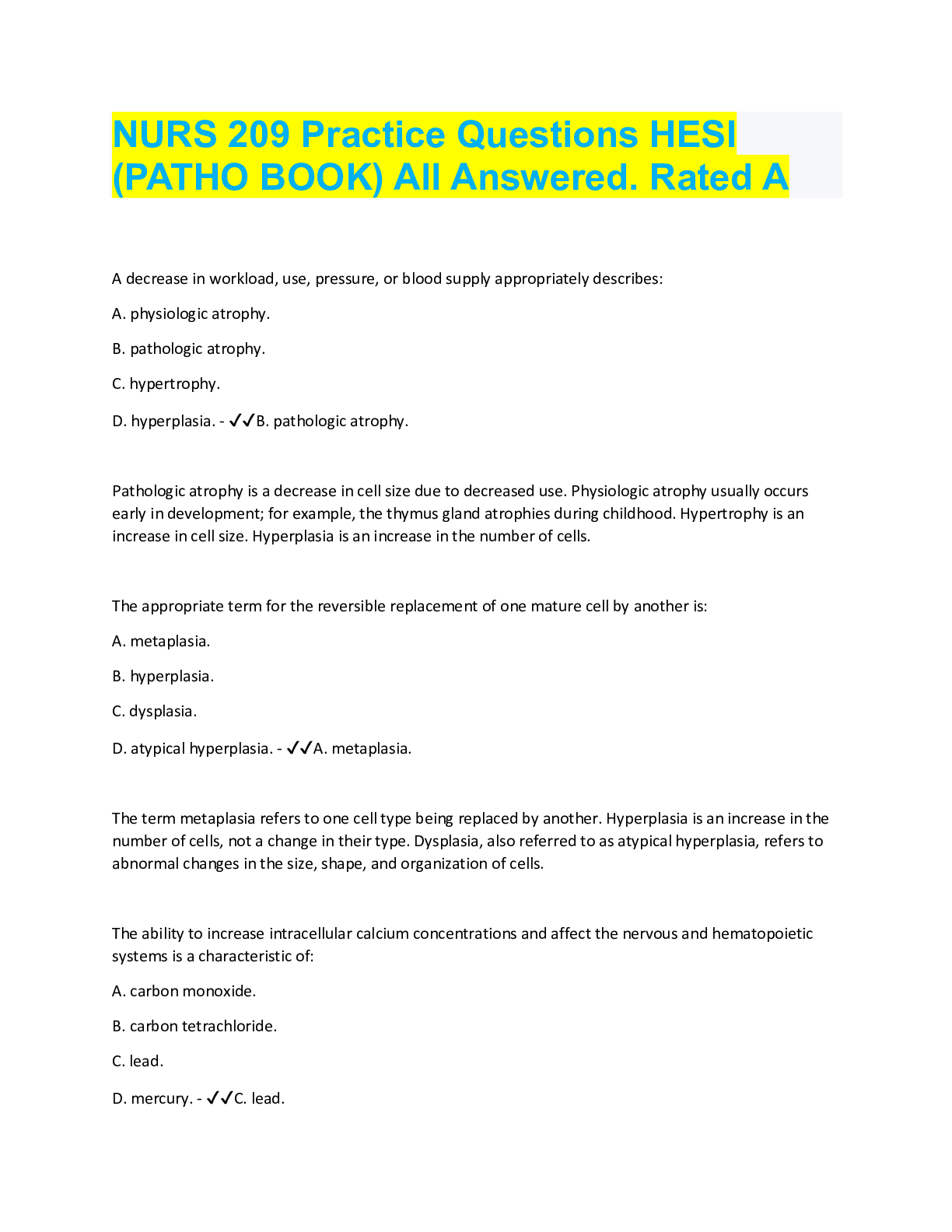
Reviews( 0 )
Document information
Connected school, study & course
About the document
Uploaded On
Mar 28, 2022
Number of pages
88
Written in
Additional information
This document has been written for:
Uploaded
Mar 28, 2022
Downloads
0
Views
39

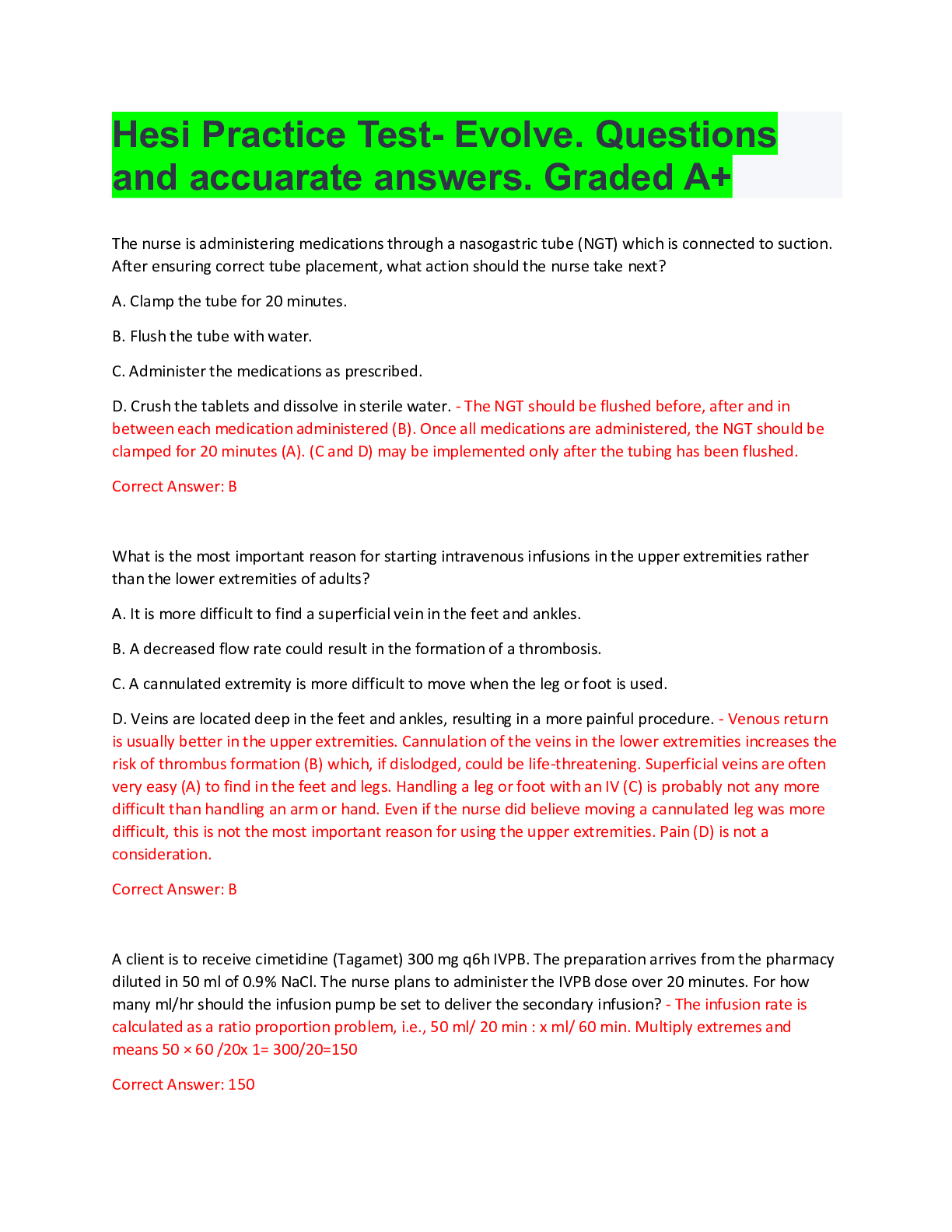
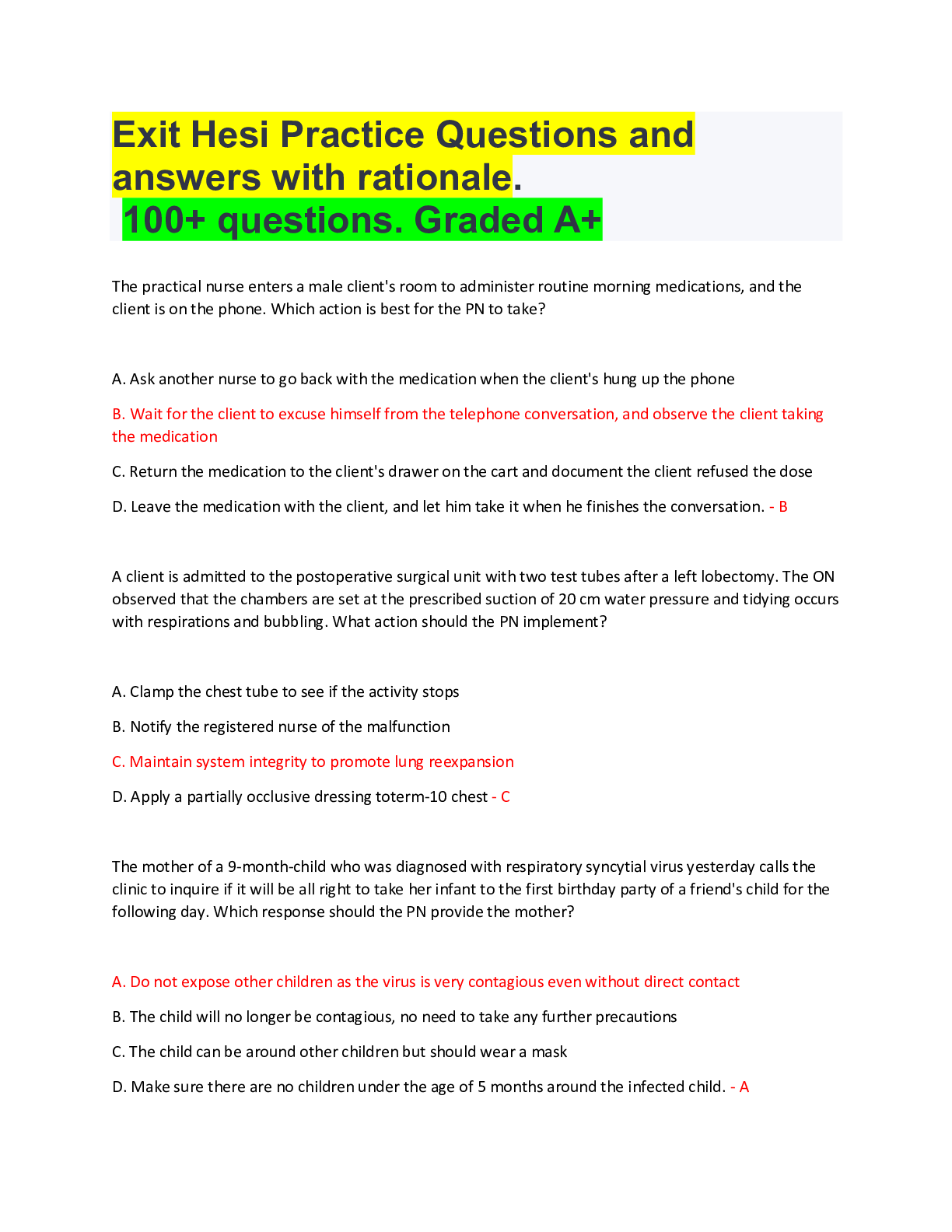

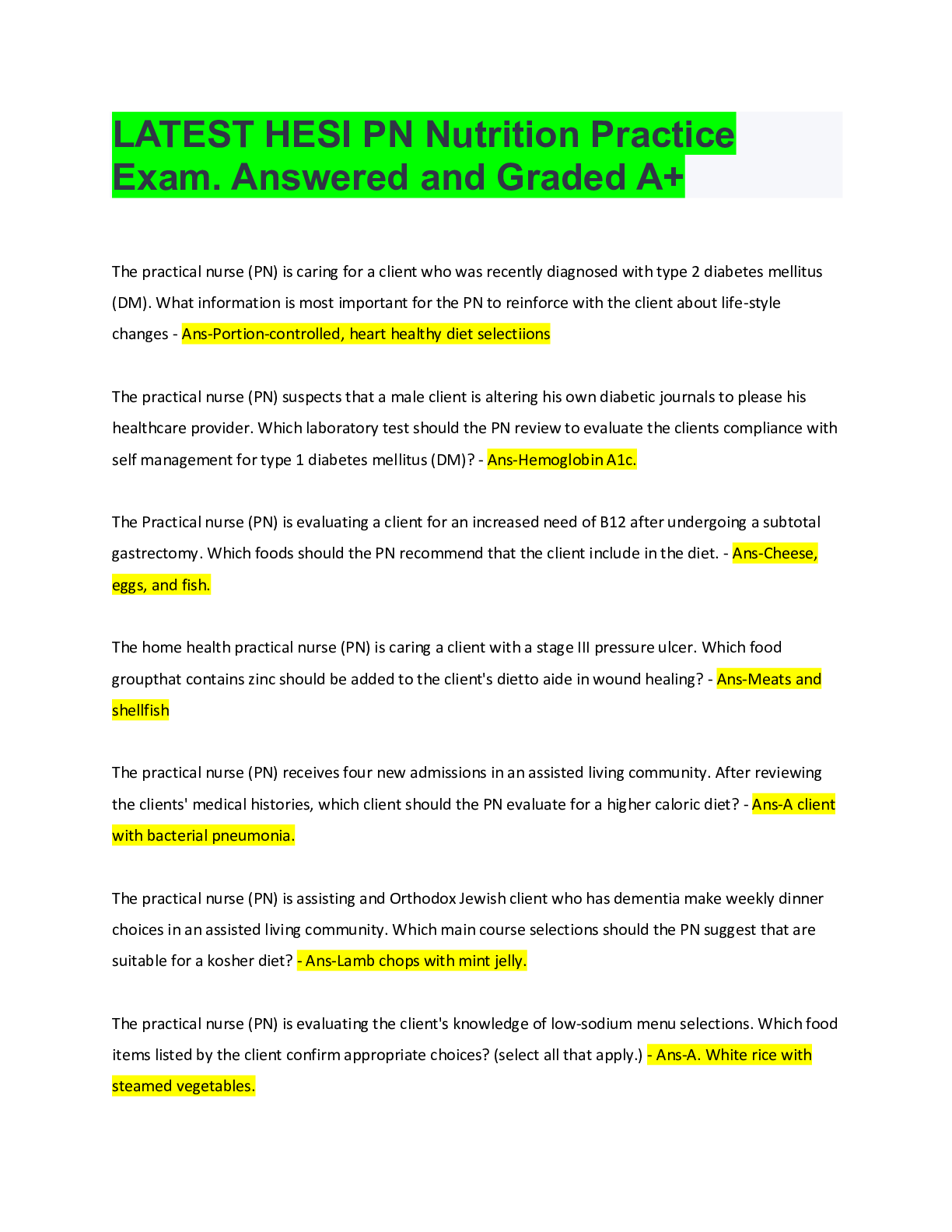


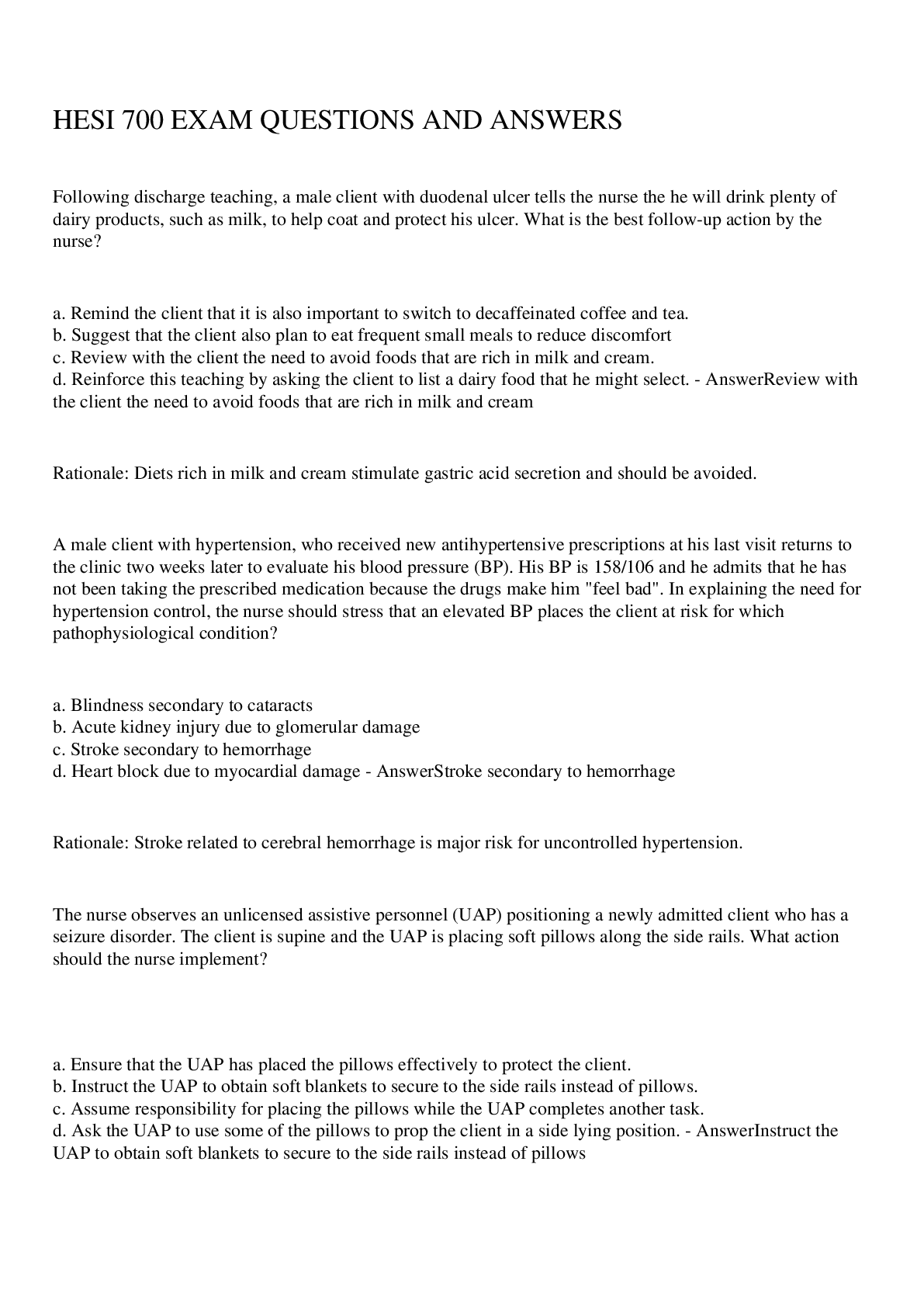


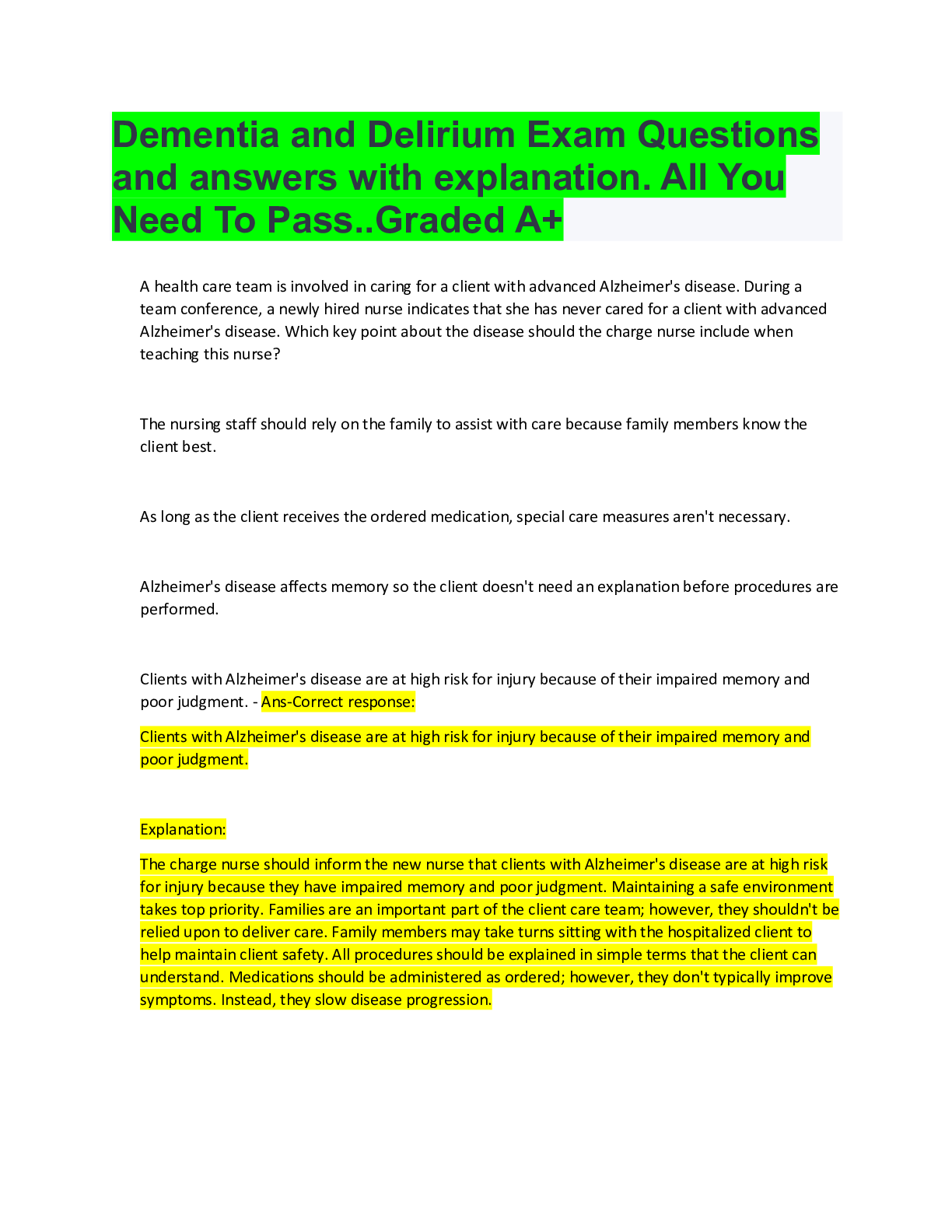


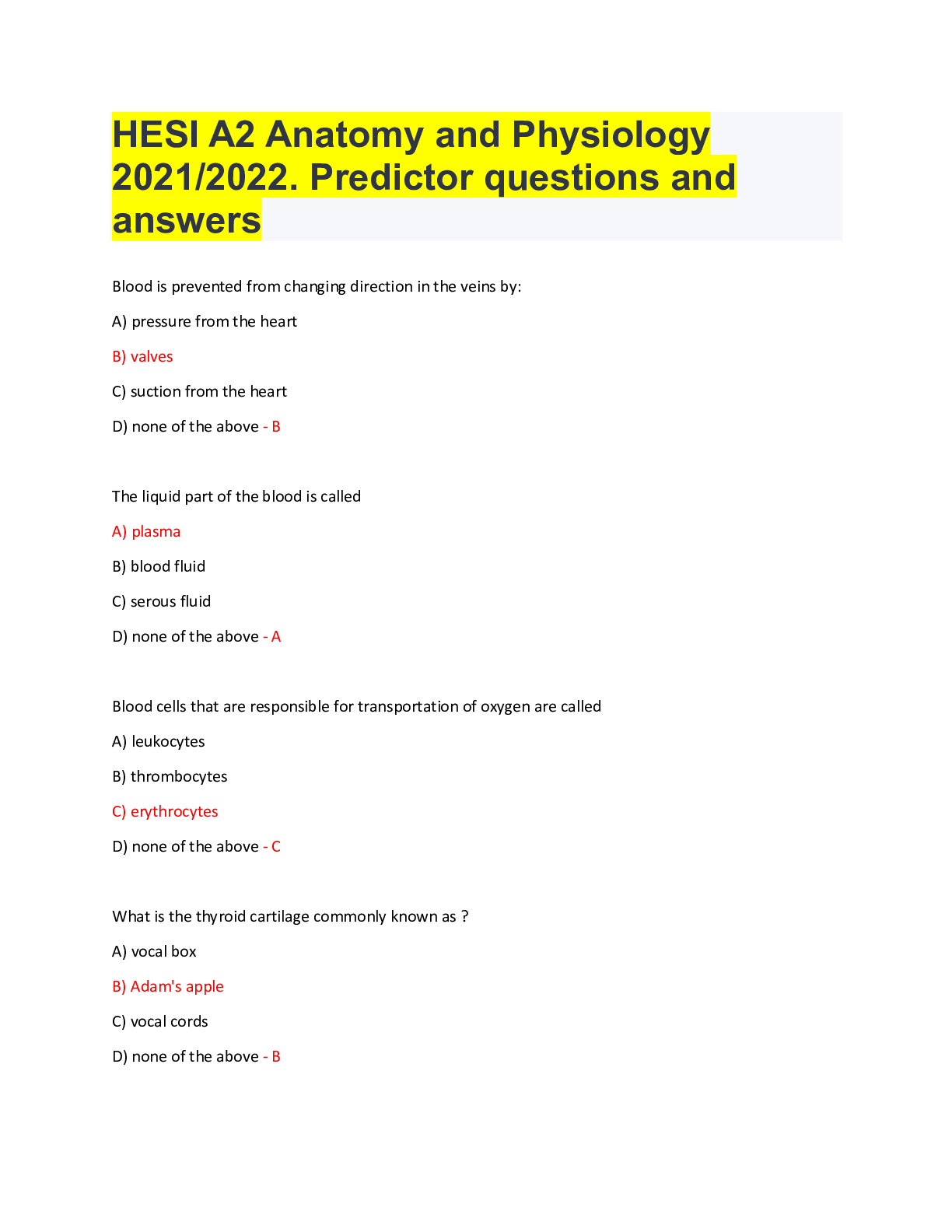

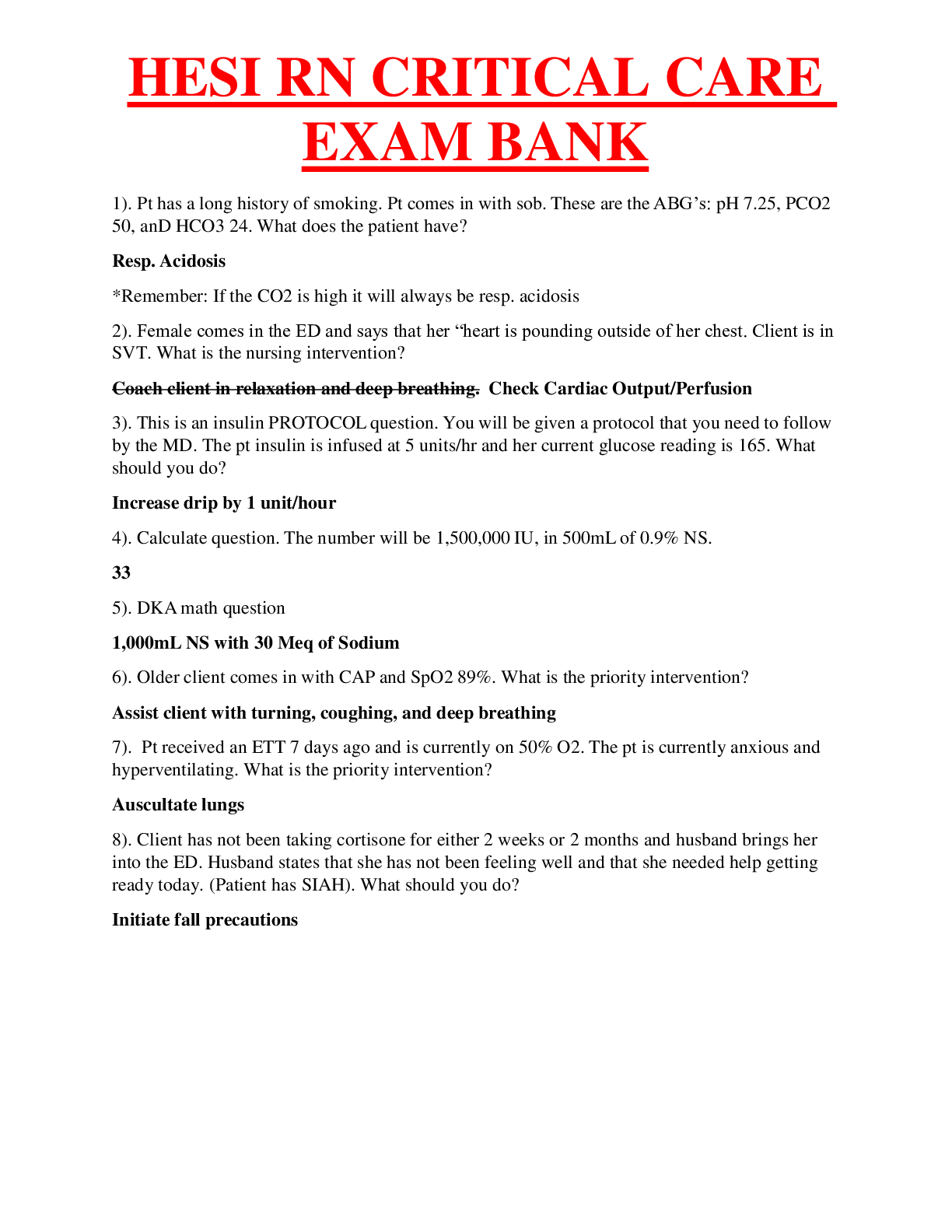
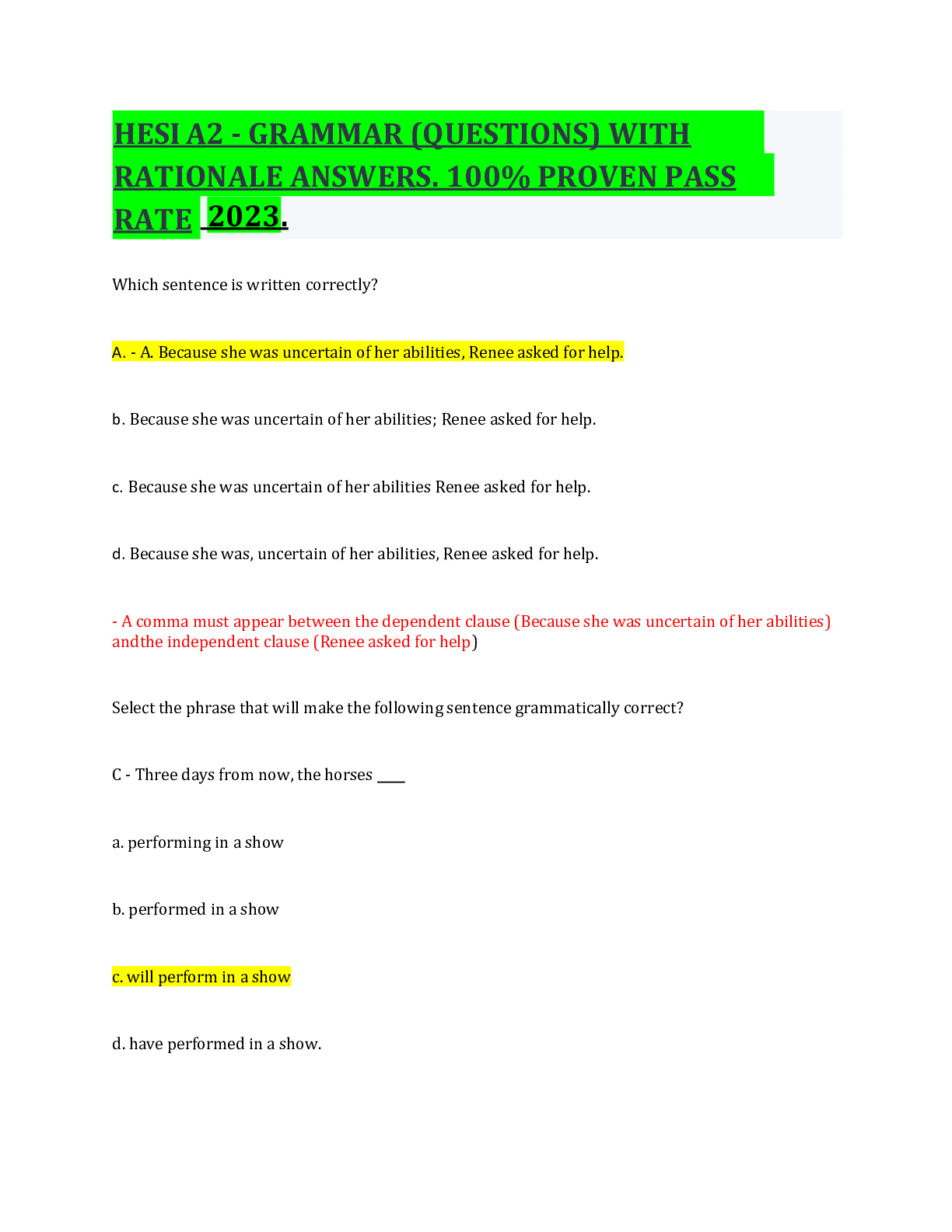
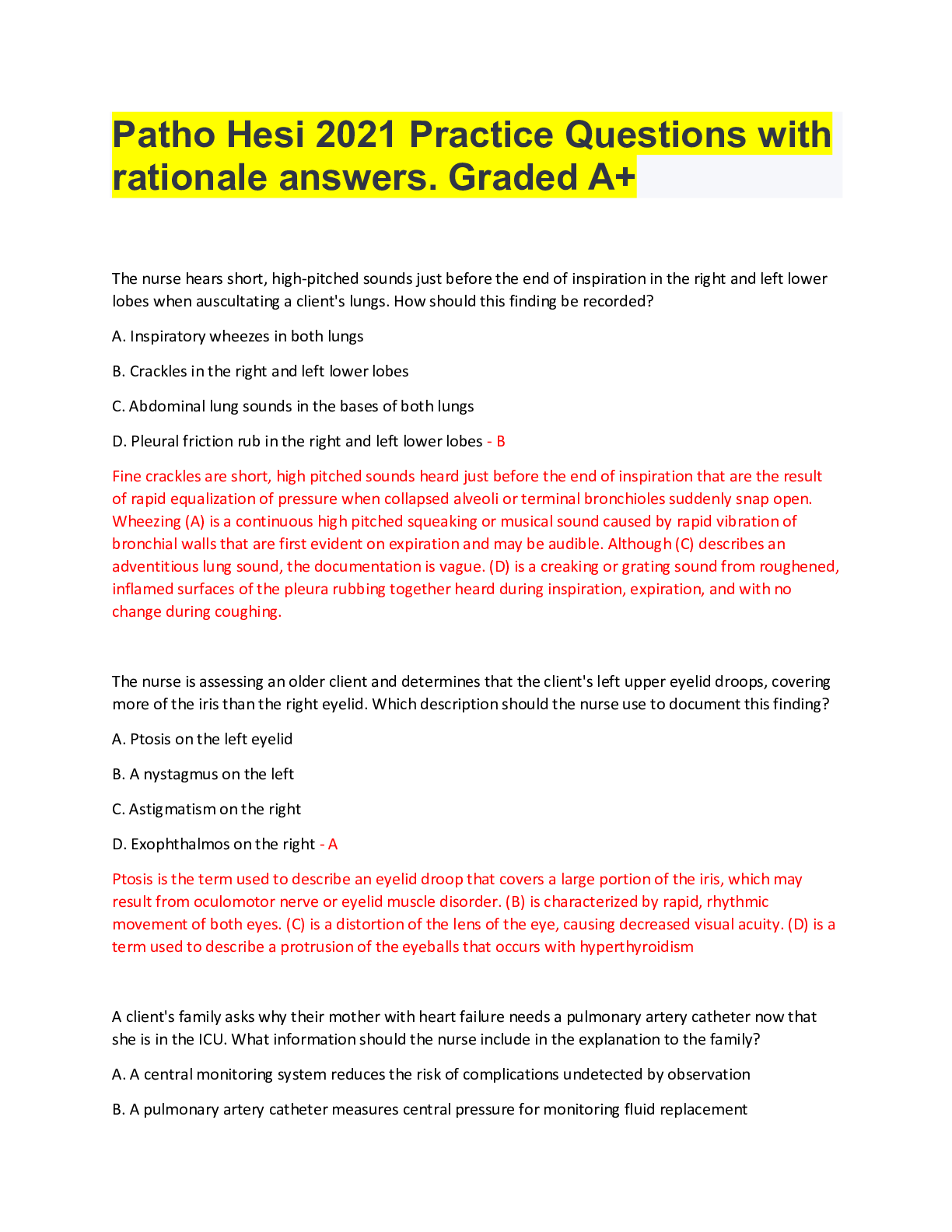
.png)
.png)

